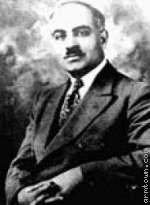The following is an excerpt from an article by Roger W. Smith (College of William and Mary Williamsburg, Virginia), Eric Markusen (Southwest State University Marshall, Minnesota), and Robert Jay Lifton (The City University of New York) titled “Professional Ethics and Denial of the Armenian Genocide”.
The Armenian Genocide and Turkey's Attempt to Deny It
From 1915 to 1917 the Young Turk regime in the Ottoman Empire carried out a systematic, premeditated, centrally planned genocide against the Armenian people. One of the documents authenticated by Turkish authorities in 1919 is a telegram sent in June 1915 by Dr. Sakir, one of the leaders of the secret organization that carried out the planning and implementation of the Genocide. He asks the provincial party official who is responsible for carrying out the deportations and massacres of Armenians within his district: "Are the Armenians, who are being dispatched from there, being liquidated? Are those harmful persons whom you inform us you are exiling and banishing, being exterminated, or are they being merely dispatched and exiled? Answer explicitly...."
The evidence of intent is backed also by the outcome of the actions against the Armenians: it is inconceivable that over a million persons could have died due to even a badly flawed effort at resettlement. Moreover, the pattern of destruction was repeated over and over in different parts of Turkey, many of them far from any war zone; such repetition could only have come from a central design. Further, the reward structure was geared toward destruction of the Christian minority: provincial governors and officials who refused to carry out orders to annihilate the Armenians were summarily replaced.
[Section omitted: A summary of key events of the Armenian Genocide.]
More than one million Armenians perished as the result of execution, starvation, disease, the harsh environment, and physical abuse. A people who lived in eastern Turkey for nearly 3,000 years lost its homeland and was profoundly decimated in the first large-scale genocide of the twentieth century. At the beginning of 1915 there were some two million Armenians within Turkey; today there are fewer than 60,000.
Despite the vast amount of evidence that points to the historical reality of the Armenian Genocide, eyewitness accounts, official archives, photographic evidence, the reports of diplomats, and the testimony of survivors, denial of the Armenian Genocide by successive regimes in Turkey has gone on from 1915 to the present.
The basic argument of denial has remained the same, it never happened, Turkey is not responsible, the term "genocide" does not apply. The tactics of denial, however, have shifted over the years. In the period immediately after World War I the tactic was to find scapegoats to blame for what was said to be only a security measure that had gone awry due to unscrupulous officials, Kurds, and common criminals. This was followed by an attempt to avoid the whole issue, with silence, diplomatic efforts, and political pressure used where possible. In the 1930s, for example, Turkey pressured the U.S. State Department into preventing MGM Studios from producing a film based on Franz Werfel's The Forty Days of Musa Dagh, a book that depicted aspects of the Genocide in a district located west of Antioch on the Mediterranean Sea, far from the Russian front.
In the 1960s, prompted by the worldwide commemoration of the fiftieth anniversary of the Genocide, efforts were made to influence journalists, teachers, and public officials by telling "the other side of the story." Foreign scholars were encouraged to revise the record of genocide, presenting an account largely blaming the Armenians or, in another version, wartime conditions which claimed the lives of more Turks than Armenians. Thereafter, Turkey tried to prohibit any mention of the Genocide in a United Nations report and was successful in its pressure on the Reagan and Bush administrations in defeating Congressional resolutions that would have designated April 24 as a national day of remembrance of the Armenian Genocide. The Turkish government has also attempted to exclude any mention of the Genocide from American textbooks. Stronger efforts still have been made to prevent any discussion of the 1915 genocide being formally included in the social studies curriculum as part of Holocaust and genocide studies.
There have also been attempts by the Turkish government to disrupt academic conferences and public discussions of the Genocide. A notable example was the attempt by Turkish officials to force cancellation of a conference in Tel Aviv in 1982 if the Armenian Genocide were to be discussed, demands backed up with threats to the safety of Jews in Turkey. The U.S. Holocaust Memorial Council reported similar threats over plans to include references to the Armenian Genocide within the interpretive framework of the Holocaust Memorial Museum in Washington. At the same time, Turkey has sought to make an absolute distinction between the Holocaust and the Armenian Genocide, defining the latter as "alleged" or "so-called." The documents we have, however, show that, in private, such labeling drops off.
Finally, in the 1980s the Turkish government supported the establishment of "institutes", whose apparent purpose was to further research on Turkish history and culture. At least one also was used to further denial of Turkish genocide and otherwise improve Turkey's image in the West.
####
In addition to continuing the denial efforts described in the article above, presently the Turkish government has hired former Congressmen to lobby on its behalf. Former Reps. Bob Livingston (R-LA) and Gerald Solomon (R-NY), who are each paid $700,000 as well as former Rep. Stephen Solarz (D-NY) who is paid $400,000, are aggressively attempting to rally Republican and Democratic opposition against official U.S. recognition of the Armenian Genocide.
Friday, April 18, 2008
Subscribe to:
Post Comments (Atom)

No comments:
Post a Comment